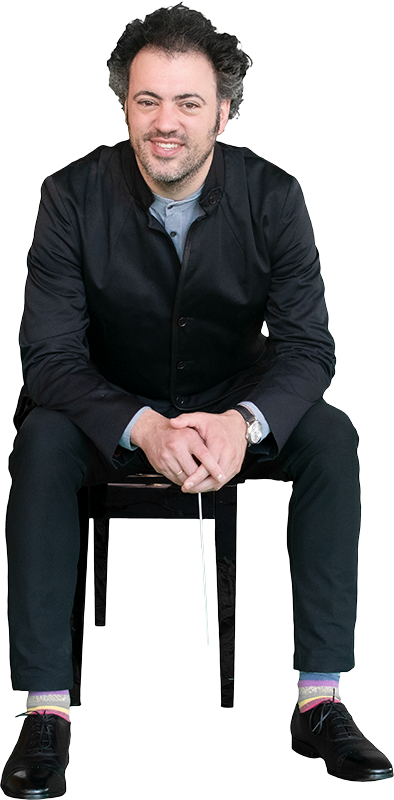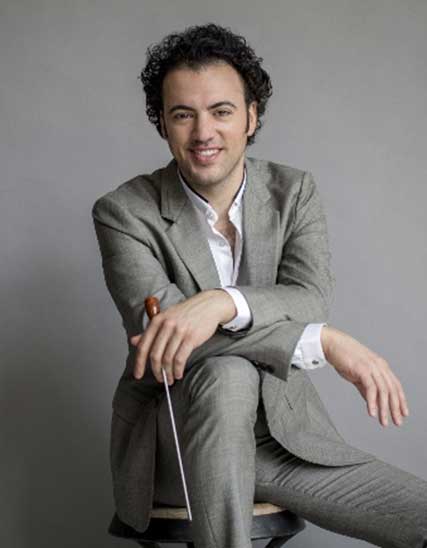What about the music?
An inside look with the Virginia Symphony Orchestra
Highlight: Violinist Gil Shaham Returns

The Performers

Gil Shaham
Violinist Gil Shaham will perform Antonin Dvorak’s Violin Concerto with the VSO.
Gil Shaham is one of the foremost violinists of our time; his flawless technique combined with his inimitable warmth and generosity of spirit has solidified his renown as an American master. The Grammy Award-winner, also named Musical America’s “Instrumentalist of the Year,” is sought after throughout the world for concerto appearances with leading orchestras and conductors, and regularly gives recitals and appears with ensembles on the world’s great concert stages and at the most prestigious festivals.
Highlights of recent years include the acclaimed recording and performances of J.S. Bach’s complete sonatas and partitas for solo violin. In the coming seasons in addition to championing these solo works he will join his long time duo partner pianist, Akira Eguchi in recitals throughout North America, Europe, and Asia.
Gil Shaham was awarded an Avery Fisher Career Grant in 1990, and in 2008 he received the coveted Avery Fisher Prize. In 2012, he was named “Instrumentalist of the Year” by Musical America. He plays the 1699 “Countess Polignac” Stradivarius, and lives in New York City with his wife, violinist Adele Anthony, and their three children.

Eric Jacobsen
Hailed by the New York Times as “an interpretive dynamo,” conductor and cellist Eric Jacobsen has built a reputation for engaging audiences with innovative and collaborative programming. He is the newly-named Music Director of the Virginia Symphony, becoming the 12th music director in the orchestra’s 100-year history.
Jacobsen is Artistic Director and conductor of The Knights, and serves as the Music Director for the Orlando Philharmonic Orchestra. Jacobsen founded the adventurous orchestra The Knights with his brother, violinist Colin Jacobsen, to foster the intimacy and camaraderie of chamber music on the orchestral stage.
Eric splits his time between New York and Orlando with his wife, singer-songwriter Aoife O’Donovan, and their daughter.
The Creators

“The Famous People” – Re-Compositions of 5 Dvořák “Slavonic Dances”
Curtis Stewart
Multi-GRAMMY nominated violinist/composer Curtis Stewart aims to translate stories of self determination to the concert stage – tearing down the facade of “Classical Violinist,” Curtis is in constant pursuit of his musical authenticity – treating art as a battery for realizing citizenship.
As a a soloist, Curtis has been presented by Lincoln Center, the Kennedy Center, the Eastman School of Music, The Juilliard School, Carnegie Hall, and the 2022 GRAMMY Awards, among many others. He has been commissioned for solo, orchestral and chamber works by the Virginia Symphony, the Royal Conservatory of Music, the Eastman Cello Institute, Sybsrite5, curators of the New York Festival of Song, and Carnegie Hall: Play/USA.
An avid teacher, Curtis teaches Chamber Music and “Cultural Equity and Performance Practice” at the Juilliard School; directs the Contemporary Chamber Music program at the Perlman Music Program; served on the Board of Concert Artist Guild; and conducted several orchestras, Opera pit, and all levels of music theory at the Laguardia High School for Music & Art and Performing Arts for ten years in New York City. Curtis graduated magna cum laude from the Eastman School of Music with a BA of Mathematics from the University of Rochester.
Stewart discusses his inspiration for his “Re-Imagined” Slavonic Dances below:
“In preparing for the arrangements of Dvorak’s Slavonic Dances, I was looking up the etymology of the word “slavonic” – and several articles suggest that it comes from a language of people from an area of eastern Europe where many were sold into slavery – also, “slav” is a denotation of fame or worth – families would add bori-slav or stani-slav to their names to denote fame.
I was drawn to this approach of dealing with a history of slavery within one’s family, the celebration of the dances of those peoples in Dvorak’s original works, the ownership of a name and its “rebranding” – and reflecting on the American Slave and how Black Americans deal with creating a similar sense of pride, familial storytelling and lineage in contemporary America.”

Slavonic Dances & Violin Concerto
Antonin Leopold Dvorak
(1841-1904)
Pronounced “Duh-vor-zhak”
· Czech
· Key player in the revival of Czech national identity, with many of his compositions prominently featuring folk music.
· His composition, “Slavonic Dances” was first written as two sets of piano duets in 1878 and 1886 respectively, however each set was adapted by the Dvorak himself for orchestra soon after their initial respective publications.
· Both sets feature a variety of traditional forms, and melodies evocative of Czech folk music.
· His Violin Concerto remains one of the staple pieces in the violin repertoire
· Premiered by violinist Max Bendix with the Chicago Symphony Orchestra in 1891
Musical Terms
What is a Concerto? A Concerto is an orchestral piece that is written to feature an instrumentalist performing in front of the orchestra as a solo.
How do you pronounce concerto? “Con – chair – toe” With the “chair” getting the emphasis.
Is the soloist part of the orchestra? Soloists are typically hired to play for the week. Since they are amazing at their instruments and have an uncanny ability to memorize many pieces, this is their job. Soloists perform many concerts per year throughout the country or world (depending on their popularity). The piece that they play is in their “repertoire” which means that they have performed it many times with many orchestras.
How do you choose the music/soloist? The Music Director identifies a soloist that they want and with the soloist, they choose the music to be performed. Or the Music Director may want to perform a particular concerto on a concert. They would then find a soloist who is known for performing that piece.
